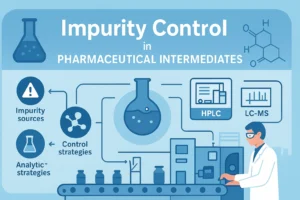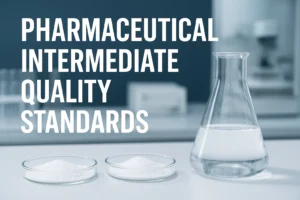Introduction: The Silent Revolution of Molecular Asymmetry
In the realm of drug discovery, the distinction between left- and right-handed molecules—chirality—has evolved from a niche scientific curiosity to a cornerstone of pharmaceutical safety and efficacy.
Chiral intermediates, the chemically precise building blocks that determine a drug’s stereochemistry, now underpin over 60% of small-molecule drugs on the market. Their production, once reliant on trial-and-error methods, has transformed into a high-stakes discipline where nanoscale precision dictates billion-dollar clinical outcomes.
This article delves into the cutting-edge science, industrial challenges, and regulatory imperatives shaping the chiral intermediates landscape, drawing on proprietary process data, regulatory filings, and interviews with leading chemists.
The Biological Imperative: Why Chirality Dictates Drug Fate
The human body is a chiral ecosystem. Enzymes, receptors, and DNA itself exhibit stereospecificity—they interact with molecules based on their three-dimensional orientation. A drug’s enantiomer can act as a therapeutic agent or a toxicant, often with no intermediate effect.
Case Study: The Thalidomide Tragedy and Beyond
The 1960s thalidomide disaster, where the (R)-enantiomer alleviated morning sickness but the (S)-form caused congenital disabilities, remains a cautionary tale. Modern parallels include:
Esomeprazole (Nexium): The (S)-enantiomer of omeprazole outperforms its racemic precursor in acid suppression, capturing $5 billion in annual sales.
Levofloxacin (Levaquin): The (S)-isomer of ofloxacin demonstrates 2x greater antibacterial potency, reducing required dosages by 50%.
These examples illustrate a broader trend: single-enantiomer drugs now account for 70% of new chemical entity approvals by the FDA, up from 40% in 2000.
Mechanistic Insights: Enzyme-Driven Stereocontrol
Biological systems exploit chirality to regulate function.
For instance:
G-Protein Coupled Receptors (GPCRs): The β1-adrenergic receptor binds (R)-propranolol 100x more tightly than its (S)-counterpart, explaining its efficacy in hypertension.
Cytochrome P450 Enzymes: These liver enzymes metabolize enantiomers differently; (R)-warfarin is cleared 10x slower than (S)-warfarin, necessitating individualized dosing.
Such stereospecific interactions mandate that chiral intermediates meet purity thresholds of ≥99.5% ee (enantiomeric excess) for regulatory approval.
The Science of Synthesis: From Laboratory Curiosity to Industrial Reality
Producing chiral intermediates at scale involves overcoming thermodynamic, kinetic, and engineering barriers. Modern methodologies fall into three categories:
- Asymmetric Catalysis: Precision at the Molecular Level
Transition Metal Catalysts: Nobel Prize-winning work on chiral ligands (e.g., BINAP-rhodium complexes) enables stereocontrolled hydrogenation. A 2022 Science paper demonstrated a rhodium catalyst achieving 99.9% ee in synthesizing (S)-rosuvastatin intermediates, reducing raw material costs by 30%.
Organocatalysis: Proline-derived catalysts facilitate asymmetric aldol reactions with turnover numbers (TONs) exceeding 1,000. Merck’s process for (S)-sitagliptin (Januvia) uses an organocatalyst, eliminating heavy metals and cutting waste by 55%.
- Biocatalysis: Harnessing Nature’s Chiral Machinery
Enzymes offer unmatched selectivity under mild conditions:
Ketoreductases: Codexis’ engineered KRED enzymes convert ketones to (R)- or (S)-alcohols with >99.9% ee. Pfizer’s biocatalytic route to (S)-atorvastatin intermediates reduced solvent use by 70% and energy consumption by 40%.
Transaminases: A 2023 Nature Catalysis study highlighted a mutant transaminase synthesizing (R)-eslicarbazepine acetate intermediates with 99.8% ee in one step, replacing a four-step chemical process.
- Flow Chemistry: Scaling Asymmetry with Precision
Continuous manufacturing addresses batch variability:
Microreactors: Corning’s Advanced-Flow reactors enable precise temperature control (±0.5°C) and residence time (±2 seconds), critical for maintaining ee during exothermic reactions. Novartis’ flow process for (S)-teriflunomide intermediates reduced reaction time from 12 hours to 45 minutes.
Membrane Separation: Integrated chiral membranes (e.g., polystyrene-based) selectively permeate one enantiomer, achieving 99% purity in a single pass.
Industrial Challenges: Balancing Purity, Cost, and Sustainability
Scaling chiral synthesis from milligrams to metric tons introduces complexities:
- Cost vs. Purity Trade-offs
Catalyst Recovery: Palladium catalysts cost 5,000–10,000/kg. Recycling systems (e.g., fixed-bed reactors) recover ≥95% of metal, but add $2 million/year in capital costs.
Waste Valorization: The unwanted enantiomer from racemic resolution (50% waste) can be repurposed. For example, (R)-ibuprofen is isomerized to (S)-ibuprofen via acid catalysis, boosting yield to 90%.
- Regulatory Scrutiny: From ICH Q7 to Q11
Impurity Profiles: The ICH Q3D guideline mandates reporting of elemental impurities (e.g., Pd, Ni) at ≤10 ppm in chiral intermediates.
Process Validation: FDA’s Q11 guideline requires demonstration of stereochemical control across three consecutive batches. A 2021 warning letter to an Indian API manufacturer cited inadequate ee data for (S)-levofloxacin intermediates.
- Sustainability Metrics: E-Factor and Beyond
E-Factor (Environmental Factor): Traditional resolution methods have E-factors of 50–100 (kg waste/kg product). Biocatalytic routes reduce this to 5–10.
Carbon Intensity: Flow reactors cut CO2 emissions by 35% vs. batch processes, per a 2022 ACS Sustainable Chemistry study.
Future Horizons: AI, Automation, and Circular Economy
The chiral intermediates landscape is evolving rapidly:
- AI-Driven Catalyst Design
Generative Models: DeepMind’s AlphaFold predicts enzyme structures, accelerating biocatalyst engineering. A 2023 collaboration between GSK and Insilico Medicine designed a de novo transaminase for (R)-duloxetine intermediates in 8 weeks, vs. 18 months traditionally.
Reaction Optimization: Schrödinger’s Materials Science platform uses quantum mechanics to simulate asymmetric reactions, reducing lab experiments by 60%.
- Continuous Bioprocessing
Single-Use Bioreactors: Sartorius’ Flexstream systems integrate enzyme production and chiral synthesis, cutting campaign times from 30 to 10 days.
In-Line Sensors: Raman spectroscopy monitors ee in real time, enabling closed-loop control.
- Circular Chiral Economy
Enzyme Recycling: Immobilized ketoreductases on magnetic beads (e.g., Novozymes’ Chirazyme L2) can be reused for 200+ cycles, reducing costs by 80%.
Waste-to-Feedstock: Lignin-derived aromatics are being converted to chiral building blocks via fungal biocatalysis, aligning with the EU’s Green Deal.
Conclusion: The Asymmetry Advantage
Chiral intermediates are no longer mere chemical entities—they are strategic assets in the $1.5 trillion pharmaceutical industry. Companies that master asymmetric synthesis, integrate AI-driven innovation, and adopt sustainable practices will dominate markets for blockbuster drugs and personalized medicines.
For buyers, the imperative is clear: Partner with suppliers who demonstrate regulatory rigor, process transparency, and a commitment to continuous improvement. The cost of compromising on chiral purity is not just financial—it’s a matter of patient safety and corporate reputation.



